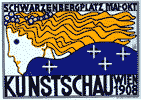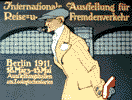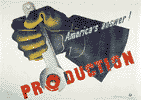|
|
A Vintage Poster Primer
In 1963, during a renovation of the offices of a Parisian literary journal, workmen found hundreds of Toulouse-Lautrec posters rolled up under the floorboards. The ones in the best condition could be bought for a few hundred dollars. Even in the 1970s, one dealer had 100 copies of Lautrec’s Divan Japonais, which he sold for $800 each. Today these posters sell for $25,000 and more. In 1989, Toulouse-Lautrec’s 3-sheet Moulin Rouge sold for $220,000, the highest price ever paid for a fine art poster at auction. When the market for vintage advertising posters emerged in the late 1970s, much of the attention focused on French artists like Lautrec, Alphonse Mucha, and Jules Cheret. Posters from these artists, as well as from those of the Art Deco period, notably Cassandre and Fix-Masseau, brought the highest prices. As the market has matured, however, it has also broadened. Scholarship and museum shows afford new discoveries every year. Italian, Swiss, Russian, Dutch, German, and British posters have developed into specialties with prices that have risen steadily in the last decade. The market has also strengthened for many category niches such as travel, Olympics, and war and propaganda. Today, virtually every poster style and period can be found, with good images that can range from a few hundred dollars to thousands. [top] |
|
|
|
| A Brief History of the Poster | |
| Cheret and the Birth of the Poster | |
|
|
Although lithography
was invented in 1798, it was at first too slow and expensive for poster
production. Most posters were woodblocks or metal engravings with little
color or design. This all changed with Cheret’s "three stone
lithographic process," a breakthrough which allowed artists to achieve
every color in the rainbow with as little as three stones - usually red,
yellow and blue - printed in careful registration.
Although the process was difficult, the result was a remarkable intensity of color and texture, with sublime transparencies and nuances impossible in other media (even to this day). This ability to combine word and image in such an attractive and economical format finally made the lithographic poster a powerful innovation. Starting in the 1870s in Paris, it became the dominant means of mass communication in the rapidly growing cities of Europe and America. The streets of Paris, Milan and Berlin were quickly transformed into the "art gallery of the street," and ushered in the modern age of advertising. [top] |
| The Belle Epoque | |
|
|
During the 1890s, called the ‘Belle Epoque’ in France, a poster craze came into full bloom. In 1891, Toulouse-Lautrec’s first poster, Moulin Rouge, elevated the status of the poster to fine art. Poster exhibitions, magazines and dealers proliferated, satisfying the public’s love affair with the poster. Early in the decade, the pioneering Parisian dealer Sagot listed 2200 different posters in his sales catalog! In 1894, Alphonse Mucha, a Czech working in Paris, created the first masterpiece of Art Nouveau poster design. The flowery, ornate style was born practically overnight when Mucha was pressed to produce a poster for Sarah Bernhardt, the brilliant actress who had taken Paris by storm. Bearing multiple influences including the Pre-Raphaelites, the Arts and Crafts Movement, and Byzantine art, this style was to dominate the Parisian scene for the next ten years and to become the major international decorative art movement up until World War I. [top] |
| The Belle Epoque Outside Paris | |
|
|
The poster slowly
took hold in other countries in the 1880s, but quickened during the Belle
Epoque. In each country, the poster came to the fore to celebrate
the society’s unique cultural institutions. In France, the cult of
the café (including absinthe and other alcoholic products) was omnipresent;
in Italy the opera and fashion; in Spain the bullfight and festivals;
in Holland literature and products for the home; in Germany trade fairs
and magazines, in Britain and America literary journals and the circus.
The first poster shows were held in Great Britain and Italy in 1894, Germany in 1896, and Russia in 1897. The most important poster show ever, to many observers, was held in Reims, France in 1896 and featured an unbelievable 1,690 posters arranged by country. Despite cross-pollination, distinctive national styles became more apparent as the Belle Epoque progressed. Dutch posters were marked by restraint and orderliness; Italian posters by their drama and grand scale; German posters for their directness and medievalism. The all-powerful influence of France had found a counterbalance. [top] |
| The New Century | |
|
|
Art Nouveau continued
after the turn of the century, although it lost much of its dynamism through
sheer imitation and repetition. The death of Toulouse-Lautrec in 1901
and the abandonment of poster art by Mucha and Cheret (who both turned
to painting) left a void in France in the new century.The void was filled
by a young Italian caricaturist named Leonetto Cappiello, who arrived
in Paris in 1898.
Strongly influenced by Cheret and Toulouse-Lautrec, Cappiello rejected the fussy detail of Art Nouveau. Instead he focused on creating one simple image, often humorous or bizarre, which would immediately capture the viewer’s attention and imagination on a busy boulevard. His 1906 Maurin Quina absinthe poster, a mischievous green devil on a black background with simple block lettering, marked the maturation of a style that would dominate Parisian poster art until Cassandre’s first Art Deco poster in 1923. This ability to create a brand identity established Cappiello as the father of modern advertising. Meanwhile, artists working in Scotland’s Glasgow School, Austria’s Vienna Secession, and Germany’s Deutscher Werkbund also were transforming Art Nouveau’s early modernist spirit. These schools rejected curvilinear ornamentation in favor of a rectilinear and geometric structure based on functionalism. A key outgrowth of these modernist efforts was the German Plakatstil, or Poster Style, which was begun in 1905 by Lucien Bernhard in Berlin. For a poster competition sponsored by Preister matches he took the novel approach of drawing two large matches and writing the brand name above them in clean, bold letters. The stark simplicity of the design won him the competition. Bernhard’s minimalized naturalism and emphasis on flat colors and shapes made his work the next step towards creating an abstract – and modern - visual language. [top] |
| World War I & the Bolshevik Revolution | |
|
|
World War I meant a new role for the poster: propaganda. Indeed, the war ushered in the biggest advertising campaign to date, critical to the wartime communication needs of every combatant – from raising money, recruiting soldiers and boosting volunteer efforts, to spurring production and provoking outrage at enemy atrocities. America alone produced about 2,500 poster designs and approximately 20 million posters – nearly 1 for every 4 citizens – in little more than 2 years. The lessons of brilliant American advertising in WWI were not lost on the Bolsheviks, who turned to poster art to help win their civil war against the Whites. Lenin and his followers proved to be the pioneering masters of modern propaganda, and the poster became a weapon which would be used throughout the century in both hot and cold wars everywhere. [top] |
| Between the Wars: Modernism & Art Deco | |
|
|
After World War
I, Art Nouveau’s organic inspiration seemed irrelevant in an increasingly
industrial society. The new realities were better expressed in the modern
art movements of Cubism, Futurism, Dada and Expressionism, all of which
would have a profound influence on graphic design.
In the Soviet Union, the Constructivist movement took hold in the ‘20s with the goal of creating a new technological society. Building on Kasimir Malevich’s Suprematist movement (the Russian outgrowth of Cubo-Futurism), the Constructivists developed an "agitational" style of composition, marked by strong diagonals, photomontage and color. Led by El Lissitsky, Alexander Rodchenko, Gustav Klutsis, and the Stenberg Brothers, the Constructivists’ work would have a major impact on Western design, primarily through the Bauhaus and the de Stijl movement. This scientific language of design was popularized in a new international decorative movement called Art Deco. In this machine age style, power and speed became the primary themes. Shapes were simplified and streamlined, and curved letterforms were replaced by sleek, angular ones. Art Deco showed a wide variety of graphic influences, from the modern art movements of Cubism, Futurism and Dada; to the design advances of the Vienna Secession, Plakatstil, and the Russian Constructivists; to the exotic art of Persia, Egypt, and Africa. The term Art Deco is derived from the "Decorative Arts" Exposition of 1925 in Paris, which proved to be a spectacular showcase for the style. In Paris, the caricature style of Cappiello gave way to the geometric, intellectual images of A.M. Cassandre, who popularized air brush techniques that lent a machine - like surface to his images. His towering posters of the Normandie, Statendam and Atlantique ocean liners became icons of the Industrial Age. Art Deco, like Art Nouveau before it, spread quickly throughout Europe. Artists of note included Federico Seneca and Giuseppe Riccobaldi in Italy, Ludwig Hohlwein in Germany, Pieter Hofman in Holland, Otto Morach and Herbert Matter in Switzerland, E. McKnight Kauffer in England, and Francisco Gali in Spain. [top] |
| World War II & the End of Stone Lithography | |
|
|
The poster again played a large communication role in World War II, but this time it shared the spotlight with other media, mainly radio and print. By this time, most posters were printed using the mass production technique of photo offset, which resulted in the familiar dot pattern seen in newspapers and magazines. The use of photography in posters, begun in the Soviet Union in the twenties, now became as common as illustration. After the war, the poster declined further in most countries as television became an additional competitor. The last gasp of the classic age of the lithographic poster occurred in Switzerland, where the government heavily promoted the printing industry and poster excellence. The establishment of a standard poster size and national kiosk system in 1914 was an additional aid. Appealing to the Swiss sense of precision, the style which developed during WWII and the early fifities in Basel was the Sachplakat, or Object Poster Style. Delighting in making everyday objects into giant icons, its roots go back to the Plakatstil of Lucian Bernhard and the Surrealist movement. The style depended on spectacular Swiss printing to create its wonderful trompe l’oeil effects. Visual elegance was often matched by gentle humor. With the end of lithographic printing in the ‘50s, Leupin, Brun and the other Basel Sachplakat artists turned to a humorous style less reliant upon the rich color and textures of lithographic printing. [top] |
| The Rise of the Postwar Information Age | |
|
|
Switzerland’s dominance of the poster field continued to grow in the late fifties with the development of a new graphic style that had roots in the Bauhaus. Because of its strong reliance on typographic elements in black and white, the new style came to be known as the International Typographic Style. Refined at design schools in Zurich and Basel, the style utilized a mathematical grid, strict graphic rules and black and white photography to provide a clear and logical structure. It became the predominant graphic design style in the world in the ‘70s, and continues to exert its influence today. The new style was perfectly suited to the increasingly global postwar marketplace. The Swiss language problem (three major languages in a small country) became a world-wide problem, and there was a strong need for clarity in word and symbol. Corporations needed international identification, and global events such as the Olympics called for universal solutions which the Typographic Style could provide. At the same time, a more relaxed and intuitive approach took hold in several countries, most notably the U.S. and Poland. Philip Meggs uses the umbrella term Conceptual Image to describe a new illustration style, one which borrowed freely from Surrealism, Pop Art and Expressionism. A famous example was Milton Glaser’s 1967 Bob Dylan record album insert. Glaser crystallized the musician’s countercultural message by portraying his long hair as a rainbow of richly flowing waves. (Glaser’s poster would anticipate a brief but spectacular psychedelic poster craze in the U.S., which recalled the floral excesses of Art Nouveau, the pulsating afterimages of Op-Art, and the bizarre juxtapositions of Surrealism). Glaser’s Push Pin Studio was matched in creativity by a dynamic school of poster art in Poland from the ‘50s through the ‘80s. The Polish School became known for a sardonic and gut wrenching variety of Surrealism in promoting the State-controlled theatre and cultural organizations. Other masters of the Conceptual Image include Armando Testa of Italy, Gunter Rambow of Germany, and Nicolas Troxler of Switzerland. [top] |
| Postmodernism & the Computer Age | |
|
|
The International Typographic Style began to lose its energy in the ‘70s and early ‘80s. Many criticized it for being cold, formal and dogmatic. A young teacher in Basel named Wolfgang Weingart led the palace revolt which ushered in today’s predominant graphic style loosely known as Postmodern design. Weingart experimented with the offset printing process to produce posters that appeared complex and chaotic, playful and spontaneous -- all in stark contrast to his elders’ teachings. Weingart’s liberation of typography was an important foundation for several new styles, from Memphis and Retro, to the advances now being made in computer graphics. The role and appearance of the poster has changed continuously over the past century to meet the changing needs of society. Although its role is less central than it was 100 years ago, the poster will evolve further as computers and the Internet revolutionize the way we communicate in the 21st century. [top] |
 |
|
PosterShow.com
|
voice:
(617) 375-0076 fax: (617) 375-0079 email: sales@internationalposter.com |
Copyright 2003 PosterShow.com





















